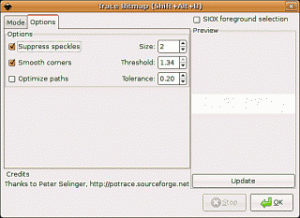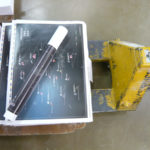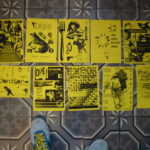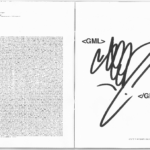Potrace –alphamax 1.334 (or the limit between artificial and natural)
Since the first time I’ve used an autotrace program -Adobe Streamline 1.0 in the early nineties- I’ve been disappointed by the unavoidable angles in curves, named kinks or cusps, that pledged the vector output. Lots of designers and developers seem not to care about it, but for me it is simply the difference between artificial shapes that scream “I’m a vector!” and natural shapes where every sharp edge is a small curve when you look really close. That kind of ultra detail may seem useless and/or nerdy, but it can really make the difference in typography. Like in my work where I use bitmaps as sources.
 So for 17 years+, I’ve tried all options and all autotrace softwares I’ve found for that simple but invisible holy grail function : a real smooth aligned anchor for all curves. No way. The only cheat strategy I’ve found was to produce polygons with no curves at all, then to round all them… Sometimes ok, but really not satisfactory.
So for 17 years+, I’ve tried all options and all autotrace softwares I’ve found for that simple but invisible holy grail function : a real smooth aligned anchor for all curves. No way. The only cheat strategy I’ve found was to produce polygons with no curves at all, then to round all them… Sometimes ok, but really not satisfactory.
A few weeks ago, during my first real hands on Inkscape, I’ve made some tests on the Potrace function. That FLOSS package will be more open to custom settings? I founded the “smooth corners” setting, like in so much other packages. After a few tests, with the maximum and strange value of 1.34, it’s reveal to produce those precious precisely aligned anchors! Ma-gni-fi-que.
And today, having a bunch of tif pictures to autotrace for a “regular” “proprietary” job, I decided to try potrace more extensively and to try to process them in batch. So I read the potrace documentation, and in a flow of features I read with *real* emotion :
“-a n, --alphamax n
set the corner threshold parameter. The default value is 1. The smaller this value, the more sharp corners will be produced. If this parameter is negative, then no smoothing will be performed and the output is a polygon. The largest useful value is 4/3 or 1.334, which suppresses all corners and leads to completely smooth output.“ (from http://potrace.sourceforge.net/potrace.1.html)
So the cryptic Alphamax setting, with a 4/3 value define precisely the limit between artificial and natural in the autotrace and vector world!…
And I immediately use it :
-
rename to avoid spaces :
for file in *; do mv "$file" `echo $file | sed -e 's/ */_/g' -e 's/_-_/-/g'`; done -
convert tif files (not supported by potrace) to pbm files and insert “pbm-” at the beginning of the filename :
for pic in `ls *.tif` ; do echo "converting $pic"; convert $pic pbm-$pic.pbm; done
(it take some time : pbm files, as other portable anymap files not compressed, are ~30 x more heavy than tif) -
trace the pbm and produce eps files with “eps-” at the beginning of the filename :
for pic in `ls *.pbm`; do echo "potrace $pic"; potrace --alphamax 1.334 --turdsize 2 --longcurve --turnpolicy black -o eps-$pic.eps $pic; done
Even if it has me place three hours closer of my job’s deadline, in this rude white night in pure designer style, I continue to smile.







3 Comments ↓
1. Roland
Jan 7, 2009 at 4:28 am
Hi Pierre,
Interesting article!
I’m looking for a way to convert multiple bitmap files to vector files using autotrace. Do you know a mean to do such a thing? Could you point me to a good way? Please?
2. 73 enlaces en mi del.icio.us, marzo 2009 | Vectoralia
Mar 27, 2009 at 8:09 pm
[…] Potrace: the best autotracing for smooth curves – […]
3. Fondos de Pantalla » Blog Archive » 73 enlaces en mi del.icio.us, marzo 2009
Mar 27, 2009 at 8:48 pm
[…] Potrace: the prizewinning autotracing for uncreased curves – […]